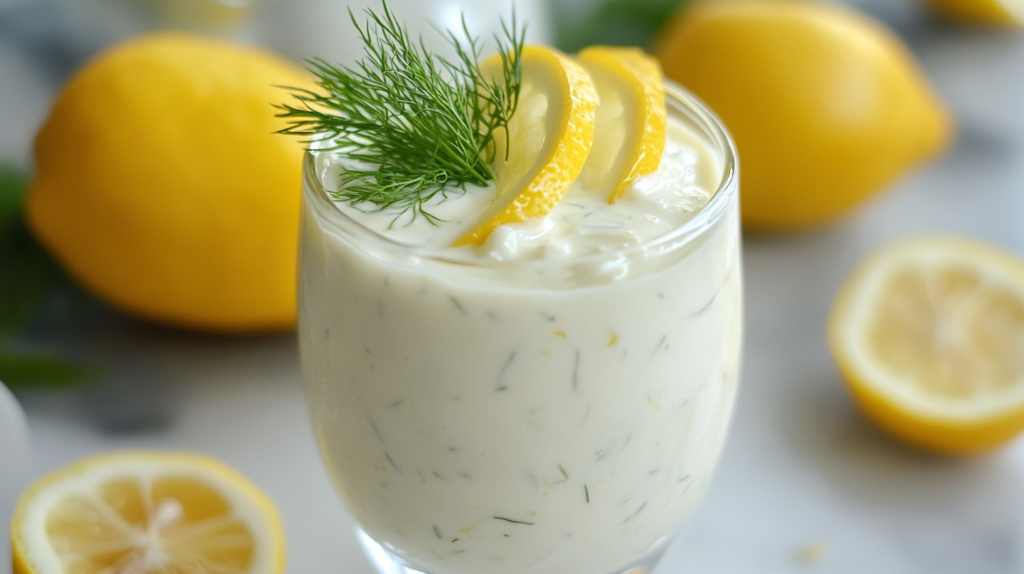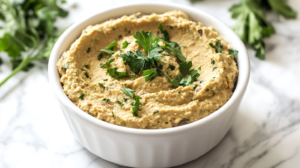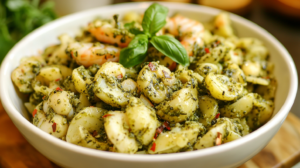Introduction to Lemon Dill Sauce
What is Lemon Dill Sauce?
Lemon dill sauce is a flavorful, creamy condiment that blends the tangy brightness of lemon with the earthy, aromatic taste of fresh dill. It often features a creamy base, such as yogurt, mayonnaise, sour cream, or a butter-and-flour roux, creating a smooth texture that enhances its versatility in various dishes. Ingredients like garlic, Dijon mustard, and a touch of sweetener like honey or sugar are often added to balance the flavors, resulting in a sauce that is zesty, fresh, and slightly herbaceous.
This sauce is celebrated for its ability to elevate the simplest dishes, offering a burst of flavor that complements a range of ingredients, particularly seafood, poultry, and vegetables.
Origins of Lemon Dill Sauce
The origins of lemon dill sauce are not tied to a single culture or cuisine but rather reflect a harmonious pairing of ingredients common in Mediterranean and Northern European cooking. Dill, a herb native to the Mediterranean and Southern Russia, has long been prized in these regions for its distinctive flavor and versatility. Similarly, lemons, with their refreshing tartness, have been a staple in Mediterranean cuisine for centuries.
The creamy versions of the sauce likely emerged from European culinary traditions that emphasize the use of dairy-based sauces, such as the French béchamel or Scandinavian cream-based condiments. In Nordic cuisine, where dill is a signature herb, a lemon dill sauce would often accompany cured or smoked fish, while Mediterranean variations lean into olive oil and garlic for a lighter take.
Culinary Uses
Lemon dill sauce is incredibly versatile and is a popular addition to many dishes around the world:
- Seafood: The tangy and herbaceous profile of the sauce makes it an ideal companion for grilled, baked, or poached fish, such as salmon, cod, or halibut. It is also commonly served with shellfish like shrimp and scallops.
- Poultry: Lemon dill sauce can enhance roasted or grilled chicken, adding a refreshing citrusy note to the dish.
- Vegetables: As a drizzle or dipping sauce, it brings out the natural sweetness of roasted asparagus, steamed broccoli, or baby potatoes.
- Dips and Dressings: When thinned slightly, the sauce makes an excellent salad dressing or a dip for raw veggies and crackers.
Its adaptability and vibrant flavor profile have made lemon dill sauce a staple in modern kitchens, blending traditional culinary roots with contemporary tastes.
Key Ingredients for Lemon Dill Sauce
Lemon: Zest and Juice
Lemon is the cornerstone of lemon dill sauce, providing its signature tangy and refreshing flavor. Both the zest and juice are used to capture the fruit’s full essence:
- Lemon Zest: The outer yellow peel of the lemon contains aromatic oils that deliver an intense citrus flavor without the acidity. Zest adds a fragrant brightness and depth to the sauce.
- Lemon Juice: The juice contributes a sharp, clean tartness that balances the creaminess of the sauce base. Freshly squeezed lemon juice is preferred for its natural taste and vibrant acidity.
The combination of zest and juice ensures the sauce has a layered citrus profile, making it both bold and balanced.
Fresh Dill and Its Flavor Profile
Dill is the herb that gives this sauce its distinctive character. Known for its feathery leaves and mildly sweet, grassy taste, dill has an anise-like undertone that pairs beautifully with lemon. When used fresh, dill’s flavor is delicate and aromatic, enhancing the sauce without overwhelming other ingredients.
- Culinary Profile: Dill complements the tanginess of lemon and adds a herbaceous, slightly licorice-like note.
- Pairing Potential: Its unique flavor makes it a natural match for seafood, poultry, and vegetables, contributing to the sauce’s wide culinary appeal.
Chopping fresh dill finely ensures even distribution throughout the sauce, allowing its flavor to shine in every bite.
Optional Enhancements
While lemon and dill are the stars, several optional ingredients can elevate the sauce and adapt it to different tastes or dishes:
- Garlic: Minced or roasted garlic adds depth and a savory note, enhancing the overall flavor complexity.
- Dijon Mustard: A spoonful of Dijon provides a subtle tang and a creamy texture, giving the sauce a touch of sophistication.
- Honey or Sugar: A small amount of sweetener can balance the acidity of the lemon and create a smoother flavor profile.
- Creamy Base Options:
- Yogurt: Adds a tangy and light creaminess, perfect for healthier versions of the sauce.
- Mayonnaise or Sour Cream: Creates a rich, velvety texture, ideal for indulgent applications.
- Butter or Roux: Gives the sauce a luxurious, silky consistency when served warm.
- Seasonings: Salt, black pepper, and sometimes a hint of paprika or cayenne are used to round out the flavors.
These enhancements allow for customization, making lemon dill sauce as simple or complex as desired, while retaining its fresh and vibrant core.
Step-by-Step Recipe for Lemon Dill Sauce
Classic Lemon Dill Sauce Recipe
Here’s a simple yet delicious recipe for making classic lemon dill sauce at home:
Ingredients:
- 1/2 cup mayonnaise or sour cream (or Greek yogurt for a lighter option)
- 2 tablespoons fresh lemon juice (about half a lemon)
- 1 teaspoon lemon zest (finely grated)
- 2 tablespoons fresh dill (finely chopped)
- 1 clove garlic (minced or finely grated)
- 1 teaspoon Dijon mustard (optional)
- 1/2 teaspoon honey or sugar (optional, for sweetness)
- Salt and black pepper to taste
Instructions:
- Prepare the Base: In a medium bowl, whisk together the mayonnaise (or sour cream/yogurt) and Dijon mustard until smooth.
- Add Lemon and Dill: Stir in the fresh lemon juice, lemon zest, and chopped dill. Mix well to ensure even distribution.
- Enhance with Garlic: Add the minced garlic, which provides a subtle depth to the flavor. If you prefer a milder garlic taste, sauté the garlic briefly in a little olive oil before adding it to the sauce.
- Balance the Flavors: If the sauce tastes too tangy, stir in the honey or sugar to mellow the acidity. Season with salt and black pepper to taste.
- Chill and Serve: Cover and refrigerate the sauce for at least 15–30 minutes to allow the flavors to meld together. Serve cold or at room temperature.
Tips for Balancing Flavors
To ensure your lemon dill sauce has the perfect harmony of flavors, keep the following tips in mind:
- Start Small with Lemon: Gradually add lemon juice and zest, tasting as you go. This allows you to adjust the tartness to suit your preference.
- Balance Acidity: If the sauce feels too sharp, a small amount of honey, sugar, or even a splash of cream can round out the tanginess.
- Adjust Consistency: For a thinner sauce (e.g., for drizzling over fish or salad), mix in a teaspoon or two of water, milk, or olive oil. For a thicker dip, add more mayonnaise, yogurt, or sour cream.
- Mind the Dill: Use fresh dill for the best flavor, but if you’re using dried dill, reduce the quantity by half since dried herbs are more concentrated.
- Customize to Taste: Add a pinch of cayenne or smoked paprika for a hint of heat or an extra layer of flavor.
By following this recipe and keeping these tips in mind, you’ll create a perfectly balanced lemon dill sauce that’s versatile and crowd-pleasing!
Variations of Lemon Dill Sauce
Creamy Version with Yogurt or Sour Cream
For a rich and creamy lemon dill sauce, incorporating yogurt or sour cream as the base creates a luscious texture with a slightly tangy profile. This version works well for both dipping and drizzling and can be customized based on your preferences.
Ingredients:
- 1/2 cup Greek yogurt or sour cream
- 1–2 tablespoons fresh lemon juice
- 1 teaspoon lemon zest
- 2 tablespoons fresh dill (finely chopped)
- 1 clove garlic (minced or grated)
- Salt and black pepper to taste
Directions:
- Combine the Greek yogurt or sour cream with lemon juice, zest, and dill in a bowl.
- Stir in the garlic and season with salt and pepper to taste.
- Chill the sauce for about 15–30 minutes before serving to let the flavors meld.
This creamy version is perfect for pairing with grilled fish, roasted vegetables, or as a topping for baked potatoes. It’s also a healthier alternative to mayonnaise-based versions, especially if you use Greek yogurt.
Vegan-Friendly Alternative
For a vegan-friendly lemon dill sauce, you can replace dairy-based ingredients with plant-based alternatives while still achieving the same tangy and fresh flavor profile. This version is ideal for those following a vegan or dairy-free diet.
Ingredients:
- 1/2 cup vegan mayonnaise or unsweetened plant-based yogurt (such as almond or soy yogurt)
- 1–2 tablespoons fresh lemon juice
- 1 teaspoon lemon zest
- 2 tablespoons fresh dill (finely chopped)
- 1 clove garlic (minced or grated)
- 1 teaspoon Dijon mustard (optional, for added depth)
- Salt and black pepper to taste
Directions:
- In a bowl, whisk together the vegan mayonnaise or plant-based yogurt with lemon juice, zest, and dill.
- Add the minced garlic and Dijon mustard (if using) for additional flavor.
- Season with salt and black pepper to taste, and let the sauce rest in the refrigerator for 15–30 minutes before serving.
This vegan version pairs beautifully with roasted vegetables, grain bowls, or as a dipping sauce for fries or veggie sticks. For added creaminess, you can include a splash of olive oil or tahini.
Both of these variations maintain the signature bright and herbaceous flavors of lemon dill sauce while catering to different dietary preferences!
How to Use Lemon Dill Sauce in Everyday Cooking
Lemon dill sauce is a versatile condiment that can effortlessly enhance a variety of dishes. Its bright, tangy, and herbaceous flavors make it a favorite addition to meals, adding a gourmet touch to even the simplest preparations. Here are some practical and delicious ways to incorporate it into your everyday cooking:

Drizzle Over Grilled Fish or Salmon
One of the most classic pairings for lemon dill sauce is with seafood, especially grilled fish or salmon. The tangy lemon and aromatic dill complement the delicate flavors of the fish while the creamy texture adds richness.
How to Use:
- For Grilled Salmon: After cooking, drizzle the sauce generously over the fillets for a refreshing contrast to the smoky, charred flavor of the grill.
- For White Fish: Use it to elevate grilled cod, halibut, or tilapia, adding a burst of freshness and moisture.
- As a Side: Serve the sauce on the side as a dipping option, allowing diners to customize their portion.
This combination works perfectly for quick weeknight dinners or elegant dinner parties.
Toss with Roasted Vegetables
Lemon dill sauce is a great way to add flavor and a creamy texture to roasted vegetables, turning a simple side dish into a showstopper. The acidity from the lemon and the herbal note of dill complement the caramelized sweetness of roasted vegetables.
How to Use:
- Roast your favorite vegetables (e.g., carrots, Brussels sprouts, broccoli, or asparagus) with olive oil, salt, and pepper.
- Once roasted and slightly cooled, toss the vegetables in a few tablespoons of lemon dill sauce for a creamy coating.
- Alternatively, drizzle the sauce over the vegetables just before serving for a more rustic presentation.
This approach is particularly appealing for gatherings or meal prepping, as it adds flavor without requiring additional cooking time.
By drizzling lemon dill sauce over grilled fish or tossing it with roasted vegetables, you can effortlessly incorporate it into your everyday meals, bringing a fresh and flavorful twist to your cooking.
Frequently Asked Questions About Lemon Dill Sauce
How to Make Lemon Dill Sauce?
Making lemon dill sauce is simple and can be tailored to your preferences. Here’s a basic recipe:
Ingredients:
- 1/2 cup mayonnaise, sour cream, or Greek yogurt
- 2 tablespoons fresh lemon juice
- 1 teaspoon lemon zest
- 2 tablespoons fresh dill, finely chopped
- 1 clove garlic, minced
- Salt and black pepper to taste
Instructions:
- Combine the mayonnaise (or sour cream/yogurt) with lemon juice and zest in a bowl.
- Mix in the fresh dill and garlic.
- Season with salt and pepper, and chill for 15–30 minutes before serving.
This versatile sauce can be adjusted by adding Dijon mustard, honey, or other seasonings based on your taste.
What Is Lemon Butter Dill Sauce?
Lemon butter dill sauce is a rich and luxurious variation of the classic lemon dill sauce, featuring a warm, buttery base. It’s often used as a topping for fish or vegetables.
Ingredients:
- 1/4 cup unsalted butter
- 2 tablespoons fresh lemon juice
- 1 teaspoon lemon zest
- 2 tablespoons fresh dill, chopped
- 1 clove garlic, minced (optional)
- Salt and black pepper to taste
Instructions:
- Melt the butter in a small saucepan over low heat.
- Stir in the lemon juice, zest, and minced garlic (if using).
- Remove from heat and mix in the fresh dill.
- Season with salt and pepper, then drizzle over fish, shrimp, or steamed vegetables.
This warm, silky sauce enhances dishes with a savory richness that pairs beautifully with seafood or roasted veggies.
How to Serve Salmon with Lemon Dill Sauce?
Salmon and lemon dill sauce are a classic pairing. Here’s how to prepare a delicious dish:
Ingredients:
- 4 salmon fillets
- Olive oil, salt, and black pepper
- Lemon dill sauce (prepared ahead)
Instructions:
- Preheat the oven to 400°F (200°C) or heat a grill pan over medium-high heat.
- Drizzle olive oil over the salmon fillets and season with salt and pepper.
- For Oven Cooking: Bake the salmon for 12–15 minutes, or until it flakes easily with a fork.
- For Grilling: Cook the salmon for 4–6 minutes per side, depending on thickness.
- Spoon or drizzle the chilled lemon dill sauce over the salmon before serving, or serve the sauce on the side as a dip.
This dish is perfect for a light, flavorful dinner that’s easy to prepare yet feels indulgent.
By exploring these common questions, you can master different ways to make, adapt, and serve lemon dill sauce, whether you prefer it as a creamy condiment, a buttery topping, or a classic accompaniment to salmon.
1 https://recipes4hub.com/cold-shrimp-appetizers-quick-fresh-irresistible/
2 https://recipes4hub.com/easy-buffalo-chicken-dip-no-cream-cheese-needed/
3 https://recipes4hub.com/soccer-cheese-balls-spanish-snack-a-perfect-party-treat/



